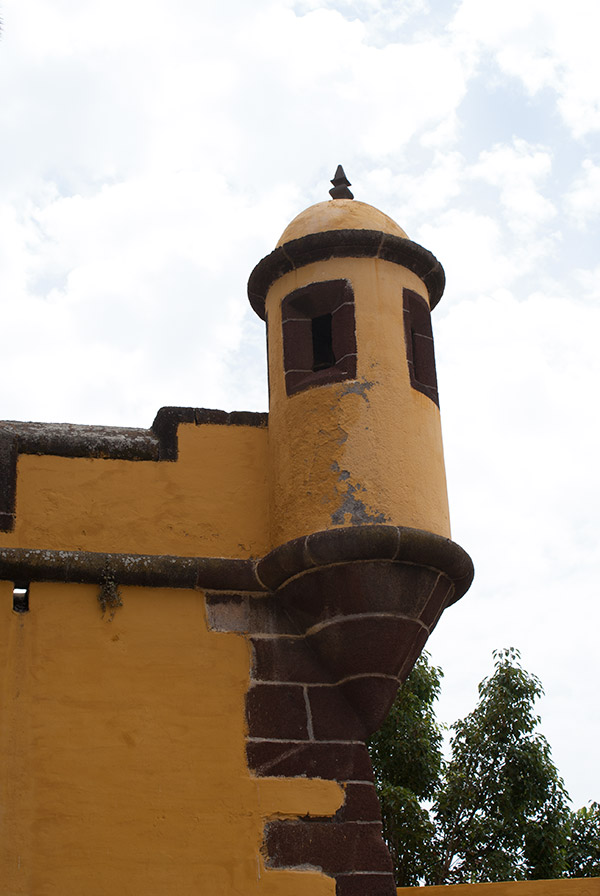 The construction of the fortress of São Tiago must have begun around 1614, as may be seen in the inscription on the primitive gate. The start of the construction should be attributed to Jerónimo Jorge, a fortifier who arrived in Madeira to replace Mateus Fernandes, author of the plans of the city walls and who worked here since 1596. After the death of Jerome George in 1617, the work was continued by his son, Bartolomeu João.The first phase of works in the fortress must have been completed in 1637, under the orders of D. Philip II of Portugal, the third of Spain. In the eighteenth century we’ll witness the second major campaign of works under the supervision of Governor Jose Correia de Sá, who acquired new weapons in London. These works were directed by the Engineer Tossi Columbina, (project author of the port of Funchal). Crowning the new gate then erected, it was placed a plaque commemorating the work, dated of 1767. Some alterations have been advanced during the Napoleonic wars period, in the early nineteenth century, and the fortress served as quartering for British troops. Already in 1803, the fortress gathered many families left homeless during the terrible flood. In the mid-century was built the house of the commander and of the guard.In the early twentieth century were again made improvements to the visit in 1901 of D. Carlos I, King of Portugal. The fortress was then the headquarters of the Mobile Artillery Battery. This unit was delivered to the Madeira Autonomous region on July 17, 1992. At the time the fortress served as quartering to the military police. The Regional Government of Madeira decided to install in the fortress, a military space and the Contemporary Art Museum, which was established in 1992. Since 1986, a selection of works of art was display dates back to Funchal City Plastic Arts Prize, an initiative carried out in 1966 and 1967 by the Official Tourism Board, and it remained there until October 2015, when the Contemporary Art Museum of Funchal was transferred to the Casa das Mudas, in Calheta, now Mudas. Museum of Contemporary Art.
The construction of the fortress of São Tiago must have begun around 1614, as may be seen in the inscription on the primitive gate. The start of the construction should be attributed to Jerónimo Jorge, a fortifier who arrived in Madeira to replace Mateus Fernandes, author of the plans of the city walls and who worked here since 1596. After the death of Jerome George in 1617, the work was continued by his son, Bartolomeu João.The first phase of works in the fortress must have been completed in 1637, under the orders of D. Philip II of Portugal, the third of Spain. In the eighteenth century we’ll witness the second major campaign of works under the supervision of Governor Jose Correia de Sá, who acquired new weapons in London. These works were directed by the Engineer Tossi Columbina, (project author of the port of Funchal). Crowning the new gate then erected, it was placed a plaque commemorating the work, dated of 1767. Some alterations have been advanced during the Napoleonic wars period, in the early nineteenth century, and the fortress served as quartering for British troops. Already in 1803, the fortress gathered many families left homeless during the terrible flood. In the mid-century was built the house of the commander and of the guard.In the early twentieth century were again made improvements to the visit in 1901 of D. Carlos I, King of Portugal. The fortress was then the headquarters of the Mobile Artillery Battery. This unit was delivered to the Madeira Autonomous region on July 17, 1992. At the time the fortress served as quartering to the military police. The Regional Government of Madeira decided to install in the fortress, a military space and the Contemporary Art Museum, which was established in 1992. Since 1986, a selection of works of art was display dates back to Funchal City Plastic Arts Prize, an initiative carried out in 1966 and 1967 by the Official Tourism Board, and it remained there until October 2015, when the Contemporary Art Museum of Funchal was transferred to the Casa das Mudas, in Calheta, now Mudas. Museum of Contemporary Art.
Given the need of restructuring the fortress, beyond being a monument open to visitors, it will “quarter” the Archaeology Lab of Madeira with the incorporation of other regional collections, coming from various archaeological excavations. The project, long desired by its relevance will be supervised by an archaeologist of the Department of Culture. The tangible cultural heritage arising from the recent archaeological intervention in the Fort of São Filipe, in Funchal, will be properly selected, treated, catalogued and preserved for later display and future memory.
A Monument Interpretation Centre will be also created in those premises, holding a wide-ranging and informative exhibition, on the defenses and fortifications of Funchal, with a historical/cultural route that has closely followed the demographic and landscape growth; the secular evolution of the fort and its geostrategic bond with other military forts to defend Funchal’s bay. This is the concept underneath the future Archeology Museum of Madeira, which will incorporate pieces from other Regional collections, coming from various archaeological excavations. The exhumed pieces are material marks from human occupation since the fifteen century until today. The typologies are diverse and quite clarifying on Madeira’s daily life and intercontinental relations during those centuries. The history of the archipelago will be revealed through artifacts, as if a buried past had emerged to support this History.